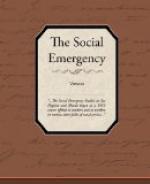Around wages most of the discussion has centered concerning the economic aspect of vice. The investigations conducted throughout the country have revealed a great variety of opinion concerning the relation between low wages and immorality. There has been much confusion of thought on the question. It is true, on the one hand, that injustice is done to wage-earning girls and women of the country when the report is circulated that the difference between morality and immorality is only one of dollars and cents. On the other hand, to deny that low wages paid to working-girls has any bearing on the question of vice is evidence of failure to grasp the moral problem involved. Morality, to be sure, is always expressed in the overcoming of difficulties. Yet we can hold a person blameworthy only if in the full possession of his or her faculties. A poorly nourished, fatigued girl has no such self-possession. If she does not earn enough on which to live, and “goes wrong,” her inadequate wage is a factor in her wrong-doing, and the one who pays it to her cannot be rid of his share of the responsibility. “Sin is misery, misery is poverty. The antidote for poverty is income,"[7] says Professor Simon N. Patten, who is doing a vast deal toward bringing economics and morals on speaking terms with each other.
Vice investigations in Chicago, Minneapolis, Portland, Oregon, Philadelphia, and elsewhere snow that there are many economic factors besides wages involved as causes of vice. Some of these other factors are housing, hours of work morally dangerous employments, associations at work, and fatigue. The wage, however, is more important than all of these, for the wage largely governs living conditions, associations and recreation. The wage often makes the difference between life as mere existence and life with the opportunities for self-improvement that should belong to a human being.
It will be of value, then, to note some of the facts about wages that have appeared in recent surveys made by the Consumers’ League of Oregon, by the State of Massachusetts, and by the Federal Government. After showing that the minimum cost of living for a self-supporting woman in Portland is $10 a week, the Oregon Survey shows that in the nine principal occupations employing women in Portland, from 22 to 92 per cent are receiving less than $10 a week. The table is as follows:—
Occupations Per cent
under
$10
Department stores 58.2
Factories 74.7
Hotels and restaurants 49.2
Laundries 92.6
Offices (clerks) 46.4
Offices (stenographers) 22.4
Printing-shops 56.1
Telephone exchanges 50.
Miscellaneous 48.7
Another table shows that in five different employments,—laundries, factories, offices, department stores, and miscellaneous employment,—out of 509 women all but 31 (office workers) close the year with a deficit.[8]




